As the business landscape evolves rapidly, businesses are increasingly realizing the significance of being agile. The Gamechangers in Resilience interview series by iluminr showcases influential leaders from across the globe who have been instrumental in fostering resilience and flexibility within their organizations, clients, and communities, enabling them to flourish even during difficult periods.
Mark Armour is a pioneer in more agile forms of Business Continuity, having co-created the Adaptive Business Continuity Manifesto, and co-written the book Adaptive Business Continuity: A New Approach. This innovative adaptation of Business Continuity, at times controversial, has been instrumental in shaping how the industry thinks about more flexible ways of bouncing forward in adversity.
Mark is currently the Sr. Global Director of Global IT Governance, Risk and Compliance at Brink’s, Incorporated, the worldwide leader in cash management solutions and secure logistics.
Q: How did you end up in the field of Resilience?
A: I applied for a business continuity position at my organization. The crazy part is I got the job!
Q: What was the inspiration behind Adaptive Business Continuity?
A: I was driven by my experience responding to events.
I was frequently struck by the fact that a considerable amount of the work I did was of little benefit when dealing with disruptions.
In one instance, I supported an impacted application development team who had been flooded out of their offices. Prior to that event, this function was considered non-critical so no time had been devoted to their preparation. When the flood occurred, it was right before an important system release. They were able to get back in operation in record time by cobbling together strategies that had been developed for other functions. All without a plan!
In another instance, I helped our training department (once again, non-critical). They had lost their training facility and were under pressure to get a significant number of new employees ready to join a very short-staffed customer service department. As with the other event, they were able to recover and deliver on their training commitments.
I also recall responding to Hurricane Katrina back in 2005. I was struck by the fact that the priorities that take so long to establish fly out the window when there is a large-scale disaster. In such situations, customers in the local markets expect different things. This not only changes the priorities of the organization but the entire industry and the very ecosystem within which it works. These are things for which you cannot develop a plan – and even if you could, it would not be applicable to the very next event.
To make an already long story short, my experiences caused me to drastically change how I view preparedness and resilience and the actions we take to improve.
Q: What are the key principles behind Adaptive Business Continuity, and how does it differ from traditional approaches to business continuity planning?
A: There are Ten Principles underlying the Adaptive approach. What makes Adaptive different is the fact that we focus on principles and not on methods. There is no defined lifecycle, no deliverables, no specified actions or procedures.
I encourage practitioners to think critically about their work. The lifecycle we’re all trained on when we join this discipline isn’t the only path to success. We should keep our minds open and always question what we’re taught or led to believe within our profession.

Q: Why is Adaptive BC so controversial?
A: Business continuity and resilience practitioners are passionate and I love that about this profession. We are all united around our goal of ensuring organizations and communities are better prepared. When we invest considerable time, effort and money in learning business continuity, it can be easy to conflate that passion for the work with the way the work is done. So, when people like me come along and state our belief that the traditional ways of working provide little or no value, it can feel personal.
Q: How have you adapted the framework over time?
A: While the programs I lead have evolved over time, I have not had to change my approach – it’s Adaptive after all!
Q: How does the Adaptive Business Continuity approach integrate with other frameworks, such as Operational Resilience?
A: Functions like Business Continuity can be relatively well defined and frameworks can be developed to guide execution. Resilience, in my opinion, is far too broad and too vague for such endeavors. It doesn’t stop people from trying, of course!
To me, resilience is a measure. It is a complex, multi-dimensional measure that is relative in nature. This means we can only say that an organization is more or less resilient, and in certain ways, when compared to another organization.
In that light, I would say that Adaptive (and business continuity in general) is one lever that can be pulled in the pursuit of improved overall resilience.

Q: What role do employees and stakeholders play in the Adaptive Business Continuity approach, and how can organizations ensure their engagement and participation in the process?
A: As a former trainer, I’m a big proponent of engagement. When we’re trying to educate people about business continuity when they haven’t asked for it, then we shouldn’t be surprised when engagement is lacking.
I believe it is our role as practitioners to understand what stakeholders need in order to be more capable responders, then focus on delivering that. Some teams need specific resources. Others may need training on those resources. Yet others may need authority to take action or make decisions.
We should meet people where they are rather than dictate what they must do – particularly if it is not natural or intuitive for them. In a complex or chaotic situation, people are always going to fall back on instinct.
Q: How can organizations measure the success of their Adaptive Business Continuity efforts, and what metrics should they use to track and evaluate their performance over time?
A: Excellent question! Regardless of the approach, I believe all business continuity programs should seek to measure outcomes and capabilities. This includes finding opportunities to execute and practice as often as possible. Such activities should be used to collect data and understand what current capabilities look like and to understand if the work being done is actually delivering demonstrable improvement.
Q: What advice would you give to teams who are looking to be more diverse and inclusive?
A: This is a particularly good question because research shows that decisions made by diverse teams result in better outcomes.
My advice is to take an honest assessment of the current state. Is there diversity of thought, culture, background, experience and perspective? Where is it lacking or where can it be better? By being deliberate and detailed, the opportunities will present themselves. I think it’s also important to be open and collaborative. If you are aware of areas where diversity is not present or can be better, share your feelings and the reasons that lead you to such conclusions. It is amazing what open and honest dialog can deliver.
Q: What is the leadership playbook you are writing for yourself in real-time?
A: One word: reflection.

Q: How do you see the concept of Adaptive Continuity being applied to industries or practices that have historically been environmentally damaging, and what role do you think sustainability considerations should play in shaping that adaptation?
A: Whew! This is a tricky one. On the one hand, Adaptive Business Continuity has the advantage of being Principles-based. This makes it flexible and more easily adapted to related disciplines such as sustainability.
When we talk about industries and practices that have been environmentally damaging and the role of sustainability in adaptability, things can get complex very quickly. For example, we have to understand that any action taken within the resilience space has potential implications for sustainability and vice-versa. Ideally, such actions will be net-positive for both but, I suspect, this will not often be the case. Even steps taken to improve sustainability have some trade-off in terms of also potentially causing environmental harm in other ways so we need to be fully cognizant of this fact and consider the best possible option. Though, more likely, we’re really just choosing from the least bad option.
Lastly, I think we need to consider these problems as consumers, ourselves, and not just as leaders, influencers or decision and policy-makers. Thinking that we can halt the damage we’re doing without causing damage elsewhere while still maintaining the level of choice and comfort we enjoy today is unrealistic. Yes, let’s help drive the change necessary but let us also make individual decisions that contribute to less impact and better outcomes, even if it means sacrificing some level of convenience.
Q: What is the hardest part about leadership in crisis?
A: It’s probably different for everyone. For me, it’s trust. I’ve seen firsthand how people can completely switch when dealing with a crisis – myself included. As much as I preach and practice empowerment, when crunch time comes, I can be the worst at sharing and delegating authority. I’ve made progress but continue to keep it top of mind with the knowledge that it is a weakness of mine.
Q: How do you apply the lessons of Resilience in your everyday life?
A: By constantly pushing myself to get out of my comfort zone and by trying to build and maintain positive relationships.














